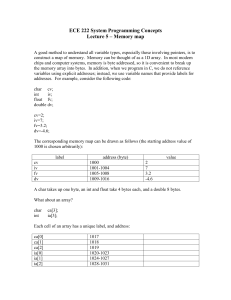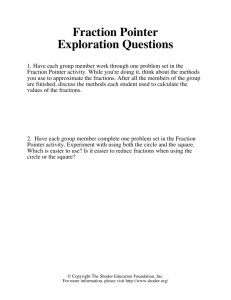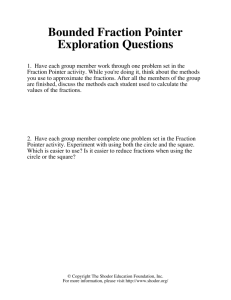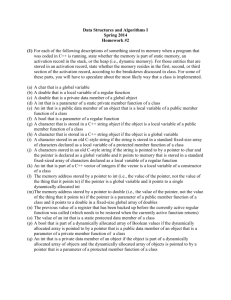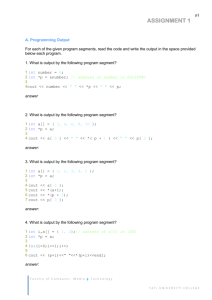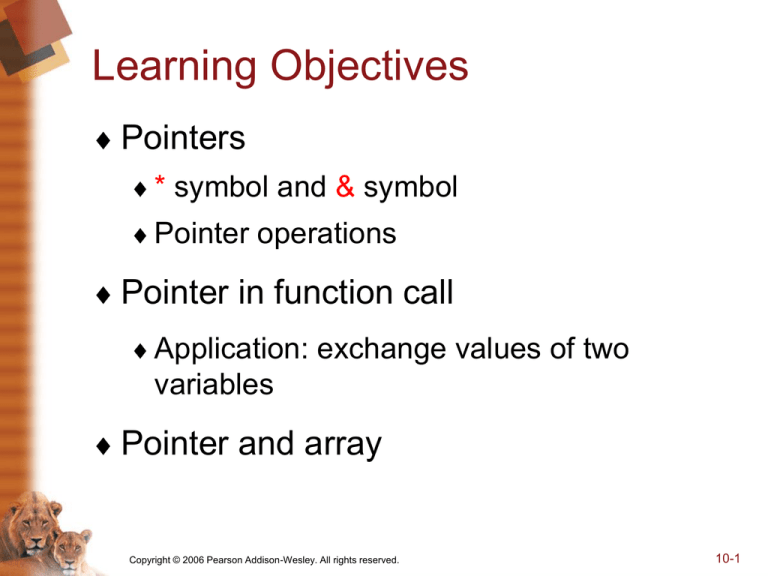
Learning Objectives
Pointers
* symbol and & symbol
Pointer operations
Pointer in function call
Application: exchange values of two
variables
Pointer and array
Copyright © 2006 Pearson Addison-Wesley. All rights reserved.
10-1
Pointer Introduction
Pointer definition:
Memory address of a variable
Recall: memory divided
Numbered memory locations
Variable name is used as address
You’ve used memory address already!
Call-by-reference
Address of actual argument was passed
Pass array in a function call
Copyright © 2006 Pearson Addison-Wesley. All rights reserved.
10-2
Pointer Variables
Pointers are "typed"
Can store addresses in variable
Pointers to int, double, etc.!
Example:
double *p;
p is declared a "pointer to double" variable
Can hold pointers to variables of type double
Not other types!
Copyright © 2006 Pearson Addison-Wesley. All rights reserved.
10-3
Declaring Pointer Variables
Pointers declared like other types
Add "*" before variable name
Produces "pointer to" that type
"*" must be before each variable
int *p1, *p2, v1, v2;
p1, p2 hold pointers to int variables
v1, v2 are ordinary int variables
Copyright © 2006 Pearson Addison-Wesley. All rights reserved.
10-4
Pointing to …
int *p1, *p2, v1, v2;
p1 = &v1;
Sets pointer variable p1 to "point to" int
variable v1
Operator, &
Determines "address of" variable
Read like:
"p1 equals address of v1"
Or "p1 points to v1"
Copyright © 2006 Pearson Addison-Wesley. All rights reserved.
10-5
Pointing to …
Recall:
int *p1, *p2, v1, v2;
p1 = &v1;
Two ways to refer to v1 now:
Variable v1 itself:
cout << v1;
Via pointer p1:
cout << *p1;
Dereference operator, *
Pointer variable "dereferenced"
Means: "Get data that p1 points to"
Copyright © 2006 Pearson Addison-Wesley. All rights reserved.
10-6
"Pointing to" Example
Consider:
v1 = 0;
p1 = &v1;
*p1 = 42;
cout << v1 << endl;
cout << *p1 << endl;
Produces output:
42
42
*p1 and v1 refer to same variable
Copyright © 2006 Pearson Addison-Wesley. All rights reserved.
10-7
& Operator
The "address of" operator
Also used to specify call-by-reference
parameter
Similar mechanism
Call-by-reference parameters pass
"address of" the actual argument
Copyright © 2006 Pearson Addison-Wesley. All rights reserved.
10-8
Pointer Assignments
Pointer variables can be "assigned":
int *p1, *p2;
p2 = p1;
Assigns one pointer to another
"Make p2 point to where p1 points"
Do not confuse with:
*p1 = *p2;
Assigns "value pointed to" by p1, to "value
pointed to" by p2
Copyright © 2006 Pearson Addison-Wesley. All rights reserved.
10-9
Pointer Assignments Graphic:
Display 10.1 Uses of the Assignment
Operator with Pointer Variables
Copyright © 2006 Pearson Addison-Wesley. All rights reserved.
10-10
Define Pointer Types
Can "name" pointer types
To be able to declare pointers like other
variables
Eliminate need for "*" in pointer declaration
typedef int* IntPtr;
Defines a "new type" alias
Consider these declarations:
IntPtr p;
int *p;
The two are equivalent
Copyright © 2006 Pearson Addison-Wesley. All rights reserved.
10-11
Pointers and Functions
Recall
Pass by value
Pass by reference
Pointers can be function parameters
Behaves like pass by reference
Example: next slide
Copyright © 2006 Pearson Addison-Wesley. All rights reserved.
10-12
void main()
{
int m = 77;
int * p = &m;
cout << "m = " << m << endl;
sneaky(p);
cout << "m = " << m << endl;
}
void sneaky(int * temp)
{
*temp = 99;
}
Copyright © 2006 Pearson Addison-Wesley. All rights reserved.
10-13
Call-by-value Pointers Graphic: The
Function Call sneaky(p);
Copyright © 2006 Pearson Addison-Wesley. All rights reserved.
10-14
Application of Pointer
Exchange values of two variables
Pass by value: won’t work
Pass by reference: will work
Pass by pointer: will work
Pass by pointer to pointer: what is this?
10-15
Pointer and array
Both array and pointer are pass by
reference in a function call
Both array and pointer refer to some
physical memory address
So, in C++, pointers can be used to
represent arrays
Any type of array (int, double, char, …)
Copyright © 2006 Pearson Addison-Wesley. All rights reserved.
10-16
Pointer and array (continued)
double a[4] = {1.1, 2.2, 3.3, 4.4};
double f = 5.5;
double *p;
p = &f;
p = a; // or p = & a[0];
// now p can be used same as a to access array
for(int i=0; i<4; i++)
cout << p[i] << "\t";
cout << endl;
10-17
Pointer and array (continued)
So, we can use pointer to represent
array, even in a function call
double a[4] = {1.1, 2.2, 3.3, 4.4};
double *p = a;
reset(p, 4); //or reset(a, 4);
for(int i=0; i<4; i++)
cout << p[i] << "\t";
void reset(double * x, int size)
{
for(int i=0; i<size; i++)
}
x[i]=5.5;
10-18
Pointer and C-String
C-String is a character array, so pointer
can be used to represent C-string
What will be displayed?
char str[] = "cs201";
cout << str << endl;
cout << "str contains " << strlen(str) << " characters" << endl;
char *p;
p = str; // p = &str[0];
cout << p << endl;
cout << "p contains " << strlen(p) << " characters" << endl;10-19
Pointer and C-String (continued)
What should be displayed?
char *p = "USA";
char *q = "Indiana";
q = p;
reset(q);
cout << "q=" << q << endl;
void reset(char * x)
{
x="IU South Bend";
}
10-20
Pointer and Array and C-String
Assigment can not be performed in array but can be
done in pointers
int m[3] = {1, 2, 3};
int n[3] = {-1, -2, -3};
m = n; // This is NOT allowed
int * p1 = m;
int * p2 = n;
p1 = p2; // This is allowed
10-21
Pointer and Array and C-String
(continued)
Assigment can not be performed in C-string but can be
done in pointers
char m[] = “Hello”;
char n[] = “South Bend”;
m = n; // This is NOT allowed
char * p1 = m;
char * p2 = n;
p1 = p2; // This is allowed
10-22


